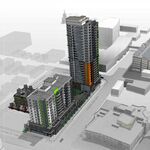Waiting for a bus that isn’t coming
By Benjamin Kabak
My gym inhabits an old bank at the corner of 5th Ave. and Union St. in Park Slope. The building has a pair of mezzanines on either end, and the treadmills are lined up facing out the windows on the second floor overlooking the avenue. With a clear view of the B63 bus shelter on the Bay Ridge side of the street, while running, I watch people wait for the bus.
A few Fridays ago, an interesting story unfolded, and while most people wouldn’t think much of it, I thought the tale is a clear indication why New York City’s transit technology is out of date and in need of an upgrade. This sordid story starts at six in the evening. I walked to the gym and noted a larger-than-usual crowd of people at the bus stop. After stretching, I hopped onto the treadmill and noted that the throngs of people were still there.
As the minutes and miles ticked by, I was struck by the scene at the bus stop. Thirteen minutes into my run, no bus had shown up. I could see frustration on the faces of those waiting for the B63. Some stood with their grocery bags staring futilely up the avenue. Others were attempting to keep their children from dashing into the street.
Nine minutes later, as I cleared the 2.5-mile mark, people started to leave. An older woman with what I guessed to be a grandson hailed a cab to points south. The younger child was growing far too impatient to wait for the bus. Four minutes later, a mother and her son headed west on Union St., bound for the R stop on Fourth Ave.
By the thirty-minute mark, as I passed 3.5 miles, nearly everyone else had left. After a series of frantic phone calls accompanied with the exasperated arm motions of someone stymied on the way home, a twenty-something woman with red hair found a cab. Others started walking along Fifth Ave. They would try to get closer to home while waiting for the bus to catch up.
By the time I hit five miles at around 41 minutes, nearly all of the original commuters had found other means of transit. New bus riders had shown up to wait. Still, though, one woman sat there. She had been sitting there when I had arrived at the gym, and she was still there afterward. I had run the equivalent of the distance from the gym to 95th St. in Bay Ridge, and still one woman waited for the bus.
On my way home, I detoured by the bus station and asked her how long she had planned to wait. “A few more minutes,†she said with a laugh. For someone waiting over 50 minutes for the bus, she had a sense of humor about her. “I thought maybe 200 people are dead somewhere,†she said. She had a book, though, and didn’t mind waiting.
As I walked back home, I glanced up Fifth Ave. and saw not one but two southbound buses heading my way. The wait would be over, and no one would ever know why the B63 didn’t show up for nearly an hour at rush hour on a Friday. With no digitized arrival board and centralized system for announcements, bus riders in the city are left with that tried, true and not too useful technique of waiting and peering. One day, we’ll catch up.




